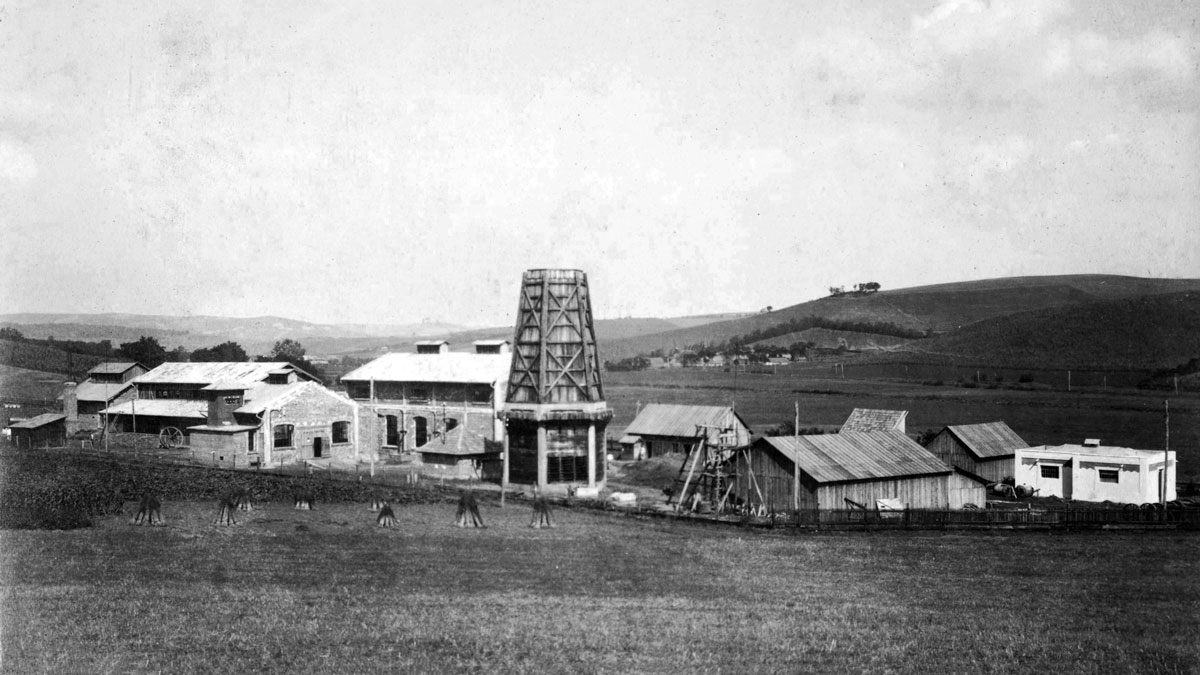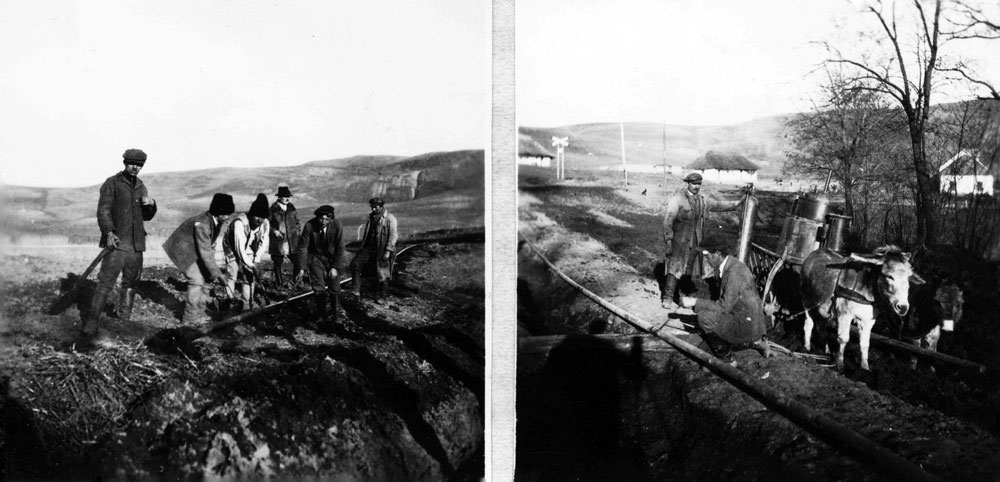Natural Gas: History and Modern Times
The saga of natural gas sprung from the Earth’s crust is utterly lost in the mists of time. Natural gas has been a mystery for mankind long before knowing what it is, where it comes from, under what conditions… For example, it was known that lighting can ignite natural gas escaping from under the Earth’s crust, causing fires to erupt, along with their consumption. It seems that most early civilizations have been overwhelmed by these flames that have become, over time, the source of many myths and superstitions…
Going back to the old springs, we find out that around 500 BC, the Chinese were the first to use natural gas, accidentally found, as by-products of salt extraction works from salt water by boiling it. Moreover, they have also found a way to transfer the gas reaching the surface of the earth, through rough pipes made of bamboo shoots, in the Ziliujing district in Sichuan.
Jumping in time, until the Renaissance, we find out that in 1626 the French explorers discovered native Americans animated by the lighting of the vapours flowing around Lake Erie. In one way, we can consider that it was for the first time when natural gas was discovered in America, and this is where the US history of natural gas could begin. Later, in 1821, William Hart, after noticing gas bubbles rising above a stream, drilled the first special well at a depth of 27 feet (just over 8 meters) for the extraction of natural gas, in Fredonia, New York. Many historians consider that Hart is the ‘father of natural gas’ in America. The company Fredonia Gas Light, founded later based on Hart’s efforts, became the first US natural gas company. And yet… Colonel Edwin Drake in 1859 drilled, by percussion drilling, the first well that brought to surface oil and natural gas, from a depth of 69 feet (around 21 meters). Most historians believe that, in fact, this is the beginning of the US natural gas history. Then, through a two-inch-diameter pipeline, the connection was made from the wellhead to the settlement of Titusville, Pennsylvania. Laying this pipeline has proven that natural gas can be carried quickly and safely from underground sources to various destinations and diverse practical applications.
On the other hand, in 1785, the UK sold for the first-time coal-derived gas, used for the first time to illuminate homes and street areas. This manufactured gas formula (unlike natural gas) was introduced for the first time in the United States, in 1816, when it was used to illuminate the streets of Baltimore. On the other hand, this artificial gas was less efficient and less environmentally friendly than natural gas coming from underground reservoirs.
Returning to US soil we notice that, out of an acute desire of producers to explore new applications, Robert Bunsen developed, in 1885, what is known today as the Bunsen burner. He was able to develop a mechanism that combines natural gas and air in adequate amounts to produce a flame that could be used for cooking and heating. The discovery of the Bunsen burner has revolutionized gas consumption in the United States and around the world. The introduction of thermostatic temperature control devices allowed a more efficient use of the natural gas heating potential, allowing the regulation, and monitoring of the flame temperature. Natural gas discovered before the Second World War was often discharged into the environment, burned when it was next to coal and oil, or simply abandoned when transporting it was inefficient.
As for natural gas transmission, we should mention that one of the first pipelines with great lengths and large diameters was built in 1891. Natural gas was transported from the wells in the centre of Indiana to Chicago, through this 12-mile-long pipeline. Unfortunately, when it came to gas transfer, this early pipeline proved to be almost ineffective. The fact is that, from that moment, no significant efforts have been made to create a pipeline system until around 1920. Then, after the Second World War, the new welding techniques, as well as progress made in the field of rolling of pipes and steel metallurgy, further increased the durability of pipelines. This post-war boom of pipeline construction lasted until 1960, allowing the construction of thousands and thousands of miles across the United States.
Romania, the first country in Europe to use natural gas in industry
Romania is known (but unfortunately less acknowledged!) as a pioneer in terms of crude oil production and one of the first countries in the world to use natural gas for industrial purposes. The first gas resources were discovered in 1909 in Sarmasel, Mures County. Romania became the first country in Europe to use natural gas in the industry, with the construction of the first transport pipeline, in 1913, which supplied brick and tile production in Sarmasu Mare. In 1914, the Sarmasel-Turda pipeline was completed and later expanded to Uioara, to supply the Solvay chemical plant and a cement factory in Turda.
Romania in 1913 produced 113 million cubic meters (mcm) of gas. The use of natural gas increased from 23 mcm in 1877 to 225 mcm in 1925. Associated gas was initially used in refineries (1924) and Ploiesti was the first city of the country that was illuminated with gas, in 1928. There was a huge inflow of international financing in Romanian oil and gas businesses starting with the last decade of the 19th century. International corporations will continue to dominate, until the end of the Second World War, in terms of both investments and technology and the production and refining capacity. In 1914, the distribution of investments in Romania’s oil sector was the following: German capital – 27.4%, British-Dutch – 47.9%, American – 6.2%, French-Belgian – 8.2%, Italian – 1.8% and Romanian – 8.1%. In 1910, compared with 1900, Western capital and know-how led to a seven-fold increase in production.
Between the First and the Second World War, the natural gas sector in Transylvania grew significantly, also due to the visionary leadership of Constantin I. Motas, general manager of the Romanian Natural Gas Company SONAMETAN, from 1919 until 1945. The war had destroyed, until 1945, almost 60% of the potential of the oil and gas industry in the country. The SovRoms, or the Soviet-Romanian cooperative enterprises, were set up to pay Romania’s obligations to Moscow, and lasted until 1956. In 1948, all oil and gas companies were nationalized. Romania was about to embark on a drifting ship over a period of decades of isolation from global money and technology. At the same time, a nationalist and authoritarian economic thinking took shape in the energy industry, whose isolationist reflexes, disconnected from global trade and technological flows, still resonate in Romanian politics.
Romania has been importing Russian gas since 1978, through the pipeline crossing Bulgaria, Turkey, Greece, and several former Yugoslav republics. Romania’s natural gas production reached a peak of 37 billion cubic meters in 1986. Subsequently, there was a continuous decline in production, which lasted until early the 1990s. Efforts in the field of oil and gas exploration by companies such as Amoco and Shell have not always led to the desired results. In 1979, the first commercial well was drilled from Gloria platform, Lebada Est, which is currently part of Istria XVIII block. Lebada Vest, Sinoe, Pescarus, Delta and others followed. For example, the Pescarus structure was discovered in 1999 and production started in 2003. The ExxonMobil – OMV Petrom consortium explored and appraised the Neptun Deep Block through two 3D seismic data acquisition programs, respectively two exploratory drilling operations, from 2008 to 2016. In 2012, the Domino-1 deep-water exploration well revealed the largest gas field in the Black Sea, with reserves estimated at over 80 billion cubic meters. Another discovery of 10-20 billion cubic meters belongs to Black Sea Oil & Gas.
Significant discoveries have also been made onshore in recent years. Therefore, we are talking about the Totea gas field, in Gorj County, discovered in 2011 by OMV Petrom, and the Caragele field, in Buzau County, discovered by Romania’s Romgaz in 2016. At the same time, in the exploration and exploitation activities, in various areas of Muntenia, Moldavia and Crisana, other companies have been involved, such as Hunt Oil, Stratum Energy, Expert Petroleum, NIS Petrol Romania and others.
In the previous years, the annual gas production was around 10.8 billion cubic meters. If we consider an annual reduction of 5% in proven reserves and a replacement ratio of 80%, the current certain gas reserves of Romania will most likely deplete within 20 years. Of course, the discovery of new reserves requires important expenses in terms of geological exploration, number of drilling operations, geological-technical research, special operations, infrastructure and more. On the other hand, the increase in production involves the use of performing technologies for the recovery of reserves from the current resources, the development of the reservoirs at drilling depths of over 3,000 meters, both onshore and in the Black Sea etc. Of course, all these involve significant investments, of several billion dollars.
At the same time, we need to also consider the gas reserves from hydrates, respectively from the so-called unconventional fields: shale gas, tight gas, and coal bed gas. For example, the amount of reserves related to shale gas, according to the forecasts of Romanian geologists, is of 1,440 billion standard cubic meters! Of course, the source rocks in the hydrocarbon basins should be analysed from a geological point of view before the actual evaluation of such resources. This means re-examining the various cores and logs, developing new research programs for exploration wells, conducting specific geological investigations etc.
By Prof. Eng. Lazar Avram, PhD, Dean of the Petroleum-Gas University of Ploiesti








